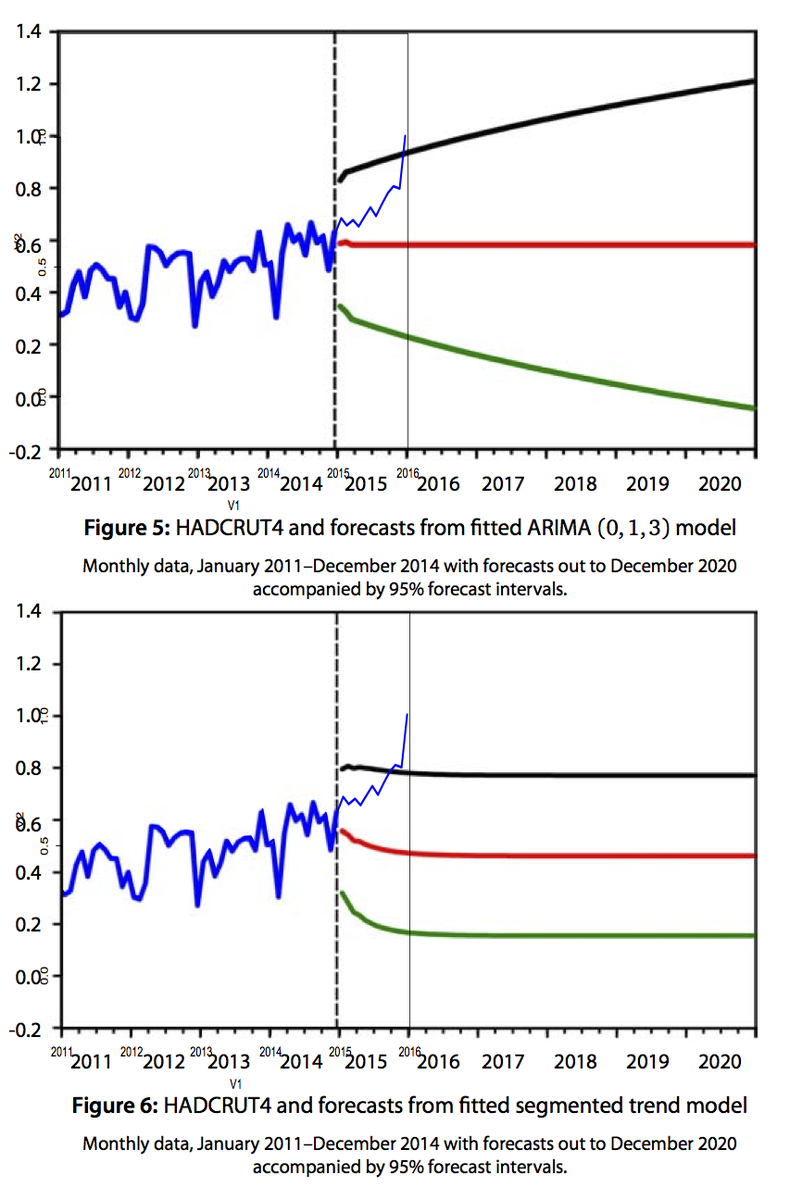at WUWT. At least, it seems so. Since the Ides of March, my comments have been going to spam, and not reappearing. Nothing has been said, but that has precedent.
Update: Ah well, it seems now that it was
all just a slip.
" I looked and he and some others were flagged unintentionally in an update to the spam list. That’s been fixed."
And it has. Thanks, John@EF for raising it there.
The recent occasion was the
thread on “One graph proves that record high year of 2015 and record months of 2016 are not AGW driven”. This has been debunked by
Sou, and by
Tamino (
twice). It's by Anthony Watts himself, and when I read it, I did not comment on the main claim, because basically, I couldn't make sense of it. It showed a plot of air temperature, tropical and global, and seemed to say that because tropical warmed first, that proved that El Nino, not AGW, was the driver of recent temperatures. I don't think the short term warming effect of El Nino is in dispute, and the earlier rise of tropical is no surprise.
My comment related to the plot initially shown. The wording seemed to suggest that this was the key graph, and no other explanation for its presence was given. The commentary starts
here (first sub-thread). I didn't see the original plot posted (Sou shows it
here), but AW had replaced it. But it was clear to me that the replacement plot wasn't temperature either. There was no Blob, for a start, and the W Pacific doesn't show any pattern like the blue stuff there. So I checked, and found the original. It was actually a plot of sea level from a Bob Tisdale post of June 2014
here, and he was illustrating with an animated GIF the passage of the Kelvin wave of that time.
So I pointed this out - the Wayback state of the post at that stage is
here. The plot itself at that stage was just captioned "2015 ENSO event". AW
rejected that, but I posted the original plot
here, which made its status quite clear.
Quite a few hours later, the post was amended, with a more descriptive caption, an added plot of actual SST during the El Nino, and a Note at the bottom, saying
"Note: based on comments, the first ENSO event graph caption was updated to clarify it, and a second SST graph was added for those who prefer that representation of the ENSO event."
I don't know why the sea level plot remained; its relevance was never explained.
Then in that sub-thread came a
confused comment from Stephen Richards. I replied to this, saying:
"Nick, go discuss with Ryan."
It's nothing to do with Ryan. He didn't release that graph. It's from a Bob Tisdale post in June 2014. He put it there to show the effect of the Kelvin wave that was crossing the Pacific at the time.
I see that a new plot has been added below which is indeed of temperature, and is in 2015. But it would be useful to have some explanation of what the graphs are and why they are included.
But when I looked back a little later, it had disappeared. I tried again with another similar comment, but that just vanished, as did a comment I made on another thread. Other comments since, on other threads, met the same fate. None have appeared.
I've had something similar happen before. In January 2015, all my comments started going into moderation. Nothing was said; it just happened. I don't know why. Sometimes (mostly) they showed on submission with a line saying "awaiting moderation", but again, sometimes they just disappeared. They did, however, eventually get through. Mostly promptly, but sometimes with a delay so that they appeared only after active discussion had passed. So this time, I thought I should wait. I submitted a couple of other comments, but the same thing. Nothing appeared.
I could try emailing, but the last time I did that, and there was no reply. I could wait a bit longer, but the last moderation stretch went on for a year, so waiting can be problematic. On that occasion, I could at least post queries to, say, tips and notes. I did that then, asking what was going on, but just got the
cryptic response [noted..mod]. I kept commenting, with delays, and odd things happened. People noticed that just mentioning my name sent their comments into moderation. In fact, the matter came to a head when not only my comments, but those that mentioned me, started going to spam, rather than moderation. One such incident
here prompted the only substantive response (to my frequent mention in comments) from the moderators about the situation, saying
[Reply: it’s the same folder. Your comments are always approved. Lots of comments are delayed for one reason or another, some by Anthony and some by WordPress. Moderators don’t have that editing authority. ~mod.]
Yes, my comments were always approved, eventually, but they always went into moderation. A few days later, the matter came to a head
here when Brandon Shollenberger found that his comments mentioning me disappeared, causing discussion. Later in that thread, for the first time in a year, my comments went through without moderation, and this continued until 15 March.
Anyway, it looks like I can't comment there any more. I used to quite enjoy the dialogues when better scientists like RG Brown were commenting. But that is a while ago - as Sou has been chronicling, scientific standards have gone down. So it's probably no great loss.
Update. I see there is discussion
initiated by John@EF at WUWT. Silence from the management there, but Larry Kummer confirms that my name now sends posts into oblivion.












